The anode voltage of a photocell is kept fixed. The wavelength λ of the light falling on the cathode is gradually changed. The plate current I of the photocell varies as follows :
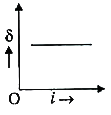
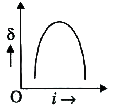
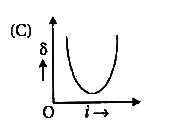

The correct Answer is:C
Initially on increases incident angle of deviation decreases where, i = e then deviation angle is minimum after that on increases incident angle i deviation angle δ also increases.
Topper's Solved these Questions
- RAY OPTICS AND OPTICAL INSTRUMENTSBOOK - KUMAR PRAKASHANCHAPTER - RAY OPTICS AND OPTICAL INSTRUMENTSEXERCISE - SECTION-D (MULTIPLE CHOICE QUESTIONS (MCQs))(MCQs FROM .DARPAN. BASED ON TEXTBOOK)(NATURAL PHENOMENA DUE TO SUN LIGHT )
11 Videos
- RAY OPTICS AND OPTICAL INSTRUMENTSBOOK - KUMAR PRAKASHANCHAPTER - RAY OPTICS AND OPTICAL INSTRUMENTSEXERCISE - SECTION-D (MULTIPLE CHOICE QUESTIONS (MCQs))(MCQs FROM .DARPAN. BASED ON TEXTBOOK)(OPTICAL INSTRUMENTS)
13 Videos
- RAY OPTICS AND OPTICAL INSTRUMENTSBOOK - KUMAR PRAKASHANCHAPTER - RAY OPTICS AND OPTICAL INSTRUMENTSEXERCISE - SECTION-D (MULTIPLE CHOICE QUESTIONS (MCQs))(MCQs FROM .DARPAN. BASED ON TEXTBOOK)(REFRACTION, MAGNIFICATION, POWER AND COMBINATION OF LENS)
29 Videos
- MOVING CHARGES AND MAGNETISMBOOK - KUMAR PRAKASHANCHAPTER - MOVING CHARGES AND MAGNETISMEXERCISE - SECTION D (MCQs ASKED IN COMPETITIVE EXAMS)
34 Videos
- SAMPLE QUESTION PAPER BOOK - KUMAR PRAKASHANCHAPTER - SAMPLE QUESTION PAPER EXERCISE - PART-B SECTION-C
5 Videos
Similar Questions
A long solenoid having n = 200 turns per metre has a circular cross-section of radius a1=1cm. A circular conducting loop of radius a2=4cm and resistance R=5(Ω) encircles the solenoid such that the centre of circular loop coincides with the midpoint of the axial line of the solenoid and they have the same axis as shown in Fig.

A current 't' in the solenoid results in magnetic field along its axis with magnitude B=(μ)ni at points well inside the solenoid on its axis. We can neglect the insignificant field outside the solenoid. This results in a magnetic flux (ϕ)B through the circular loop. If the current in the winding of solenoid is changed, it will also change the magnetic field B=(μ)0ni and hence also the magnetic flux through the circular loop. Obvisouly, it will result in an induced emf or induced electric field in the circular loop and an induced current will appear in the loop. Let current in the winding of solenoid be reduced at a rate of 75A/sec.
When the current in the solenoid becomes zero so that external magnetic field for the loop stops changing, current in the loop will follow a differenctial equation given by [You may use an approximation that field at all points in the area of loop is the same as at the centre
View SolutionThe anode vollage of a photocell is kept fixed . The wavelength λof the light falling on the cathode varies as follows
View Solution
Knowledge Check
The anode voltage of photocellis kept fixed. The wavelength λ of the light falling on the cathode is gradually changed. The plate current I of the photocell varies as follows:
A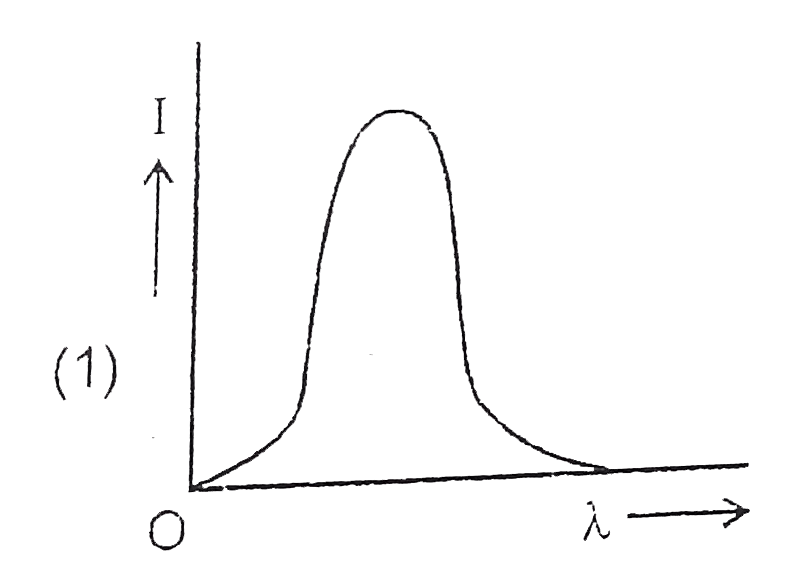 B
B C
C D
D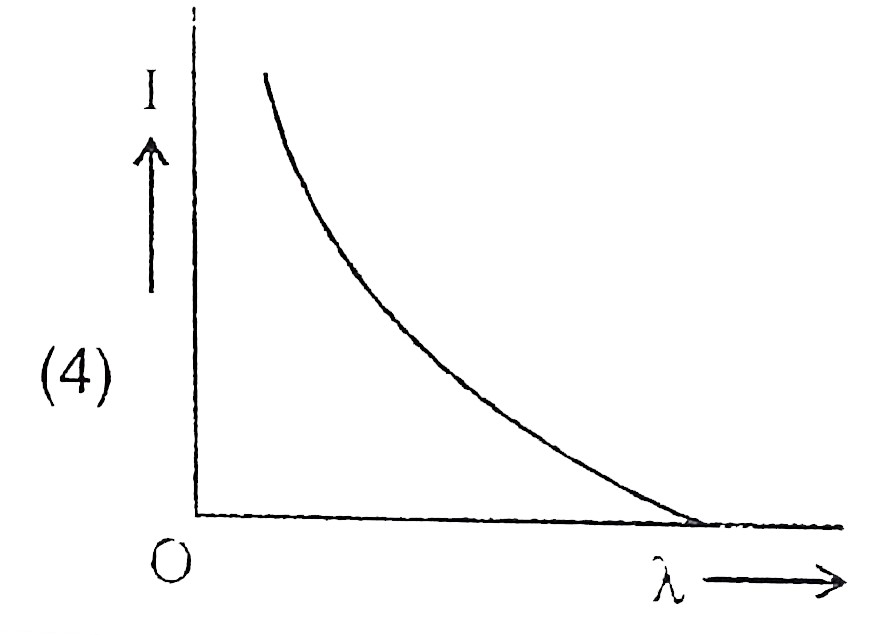
The anode vollage of a photocell is kept fixed . The wavelength λof the light falling on the cathode varies as follows
A B
B C
C D
D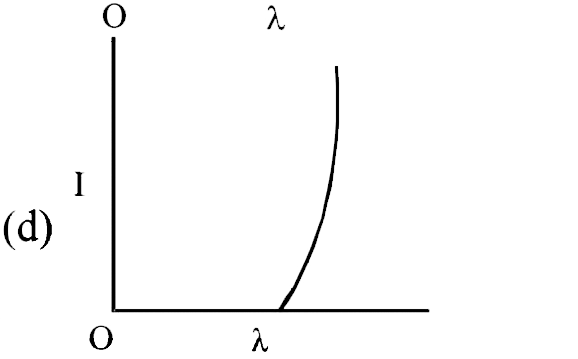
If the distance of 100 Watt lamp is increased from a photocell, the saturation current i in the photo cell varies with distance d as
Ai∝d2Bi∝dCi∝d−1Di∝d−2
Find the thickness of a plate which will produce a change in opticle path equal to half the wavelength λ of the light passing through it normally. The refractive index of the plate is μ.
View SolutionIn the experimental setup for a photocell, the wavelength of the light incident on the cathod is initially 0.6 times the threshold wavelength for the material of the cathode. Certain change in the experimental setup are given in column A and their possibel effects are given in column B.
Column AColumn B(i)The intensity of the incident light is doubled but the frequency remains unaltered(a)Photocurrent remains the same(ii)Both the intensity and wavelength of the incident light are doubled(b)Photcurrent falls to zero(iii)The intensity of the incident light is doubled and its wavelength is made half(c)Stopping potential increase(iv)The intensity of the incident light ramains the same and the wavelength is made half(d)Photocurrent increases
View SolutionA vacuum photocell consists of a central cathode and an anode. The internal surface is silver of work function 4.5 eV. The contact potential difference between the electrodes equals to 0.6 V. The photocell is illuminated by light of wavelength 2.3×10−7m.
a. What retrading potential difference should be applied between electrodes of the photocell for the photocurrent to drop to zero?
b. If a retarding potential of 1V is applied between electrodes at what limiting wavelength λ of light incident on the cathode will on the cathode will the photoelectric effect begin?
View SolutionA vacuum photocell consists of a central cathode and an anode. The internal surface is silver of work function 4.5 eV. The contact potential difference between the electrodes equals to 0.6 V. The photocell is illuminated by light of wavelength 2.3×10−7m.
a. What retarding potential difference should be applied between electrodes of the photocell for the photocurrent to drop to zero?
b. If a retarding potential of 1V is applied between electrodes at what limiting wavelength λ of light incident on the cathode will on the cathode will the photoelectric effect begin?
View SolutionThe cathode of a photocell is irradiated with light of wavelength 3000Å. The current through the cell is found to stop when the potential of the plate is 2.1 V just below the cathode. Calculate the work function of the cathode.
View Solution
